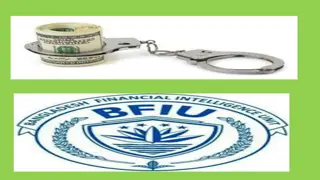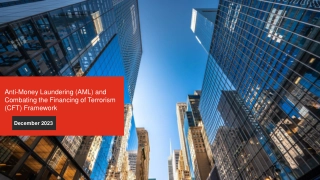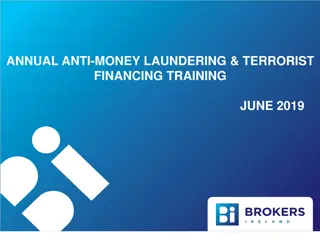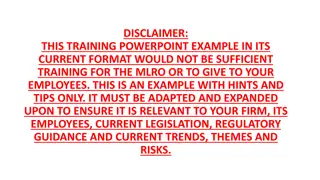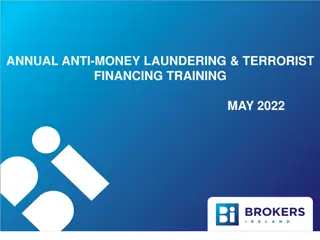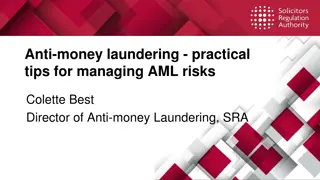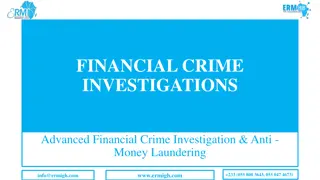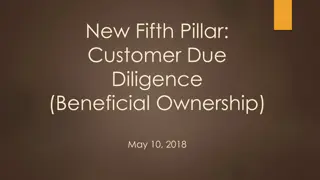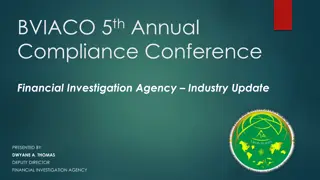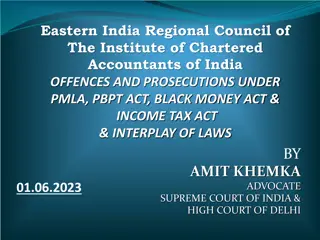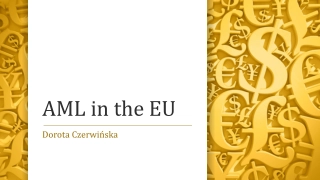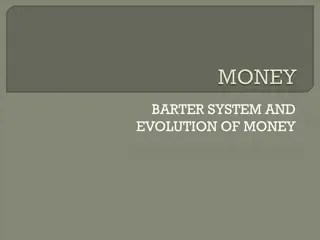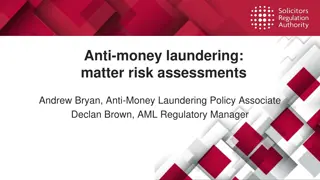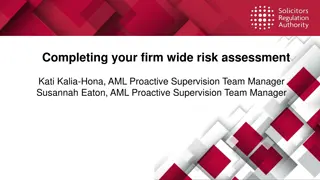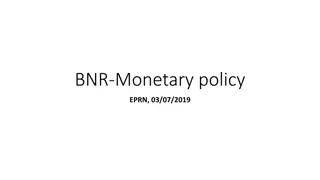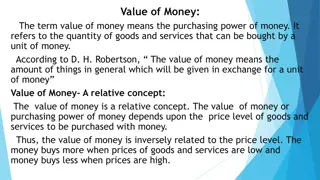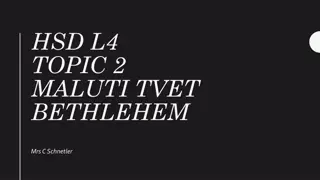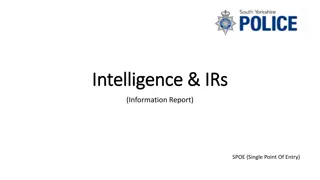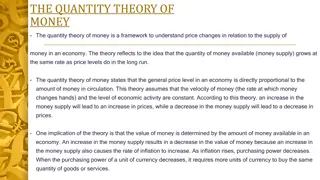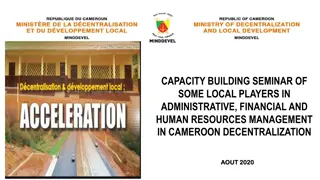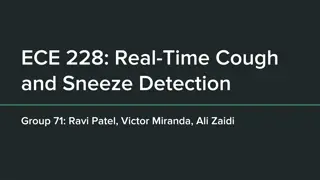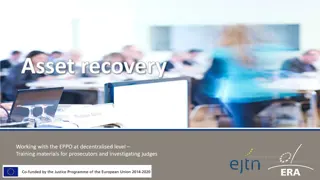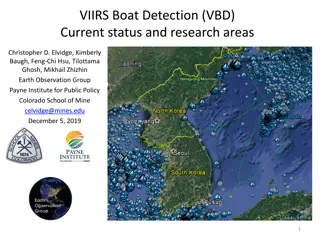Understanding Money Laundering: Detection, Prevention, and the Role of Financial Intelligence Authorities
Explore the practical aspects of detecting and preventing money laundering, with a focus on the role of the Financial Intelligence Authority in Uganda. Learn about the effects of money laundering, the obligations of accountable persons in anti-money laundering efforts, and the penalties associated with offenses. Gain insights into terrorism financing and how organizations like FIA work to combat financial crimes.
Download Presentation

Please find below an Image/Link to download the presentation.
The content on the website is provided AS IS for your information and personal use only. It may not be sold, licensed, or shared on other websites without obtaining consent from the author. Download presentation by click this link. If you encounter any issues during the download, it is possible that the publisher has removed the file from their server.
E N D
Presentation Transcript
Money Laundering :A practical approach to Detection & Prevention ESTHER AIKIRIZA KAGIRA , MANAGER, STRATEGIC ANALYSIS AND STATISTICS FINANCIAL INTELLIGENCE AUTHORITY -UGANDA
Structure of Presentation 1) Role of Financial intelligence Authority 2) Money Laundering (TF)/PF 3) Effects of Money Laundering 4) NRA 2017 5) Accountable persons and their Obligations in AML/CFT 6) Offences & Penalties 7) Conclusion (ML) and Terrorism Financing
FIA Uganda. The Financial Intelligence Authority (FIA) is a gov t agency established under section 18 of the Anti-Money Laundering Act (AMLA), 2013 to combat money laundering financing in Uganda. and terrorist FIA works with other Law Enforcement Agencies (LEAs) to protect financial sector from being abused by criminals seeking to launder proceeds of crime or fund terrorist activities. FIA s role makes it a central point between the reporting bodies/Regulators, LEAs and prosecutors. entities, supervisory
FIAs mandate Enhance the identification of the proceeds of crime and the combating of money laundering Ensure compliance with the Anti money Laundering Act Enhance public awareness and understanding of matters related to money laundering Make information collected by it available to competent authorities and to facilitate the administration and enforcement of the laws of Uganda; and facilitate spontaneous sharing of information upon request
Money Laundering (ML)? Money Laundering (ML); is the process of conversion or transfer of funds or property, knowing that such funds/property is derived from an offence involving crime or of assisting any person who is involved in the commission of such an offence. The conversion may involve changing the true nature, source, location, disposition, movement rights with respect to or ownership of property and money. When criminals generate substantial proceeds (Dirty Money) e.g. from Corruption, they must find ways to control the funds without attracting attention to the underlying activity or the persons involved.
Terrorism Financing TF is the act of providing financial support to terrorists or terrorist organizations to enable them to carry out terrorist acts. Financiers of Terrorists use similar methods as launderers to disguise and conceal their support to terror activities
Proliferation Financing Is the act of providing funds or financial services which are used, in whole or in part for the manufacture, acquisition ,possession and development of weapons of mass destruction.
Money Laundering Vs Terrorism Financing The most basic difference between ML&TF is the origin of the funds. The individuals responsible for raising funds are not the beneficiaries of the laundered funds. The money benefits a terrorist activity. However the methods used by Terrorists and Launders are technically the same.
Effects of ML .Economic Consequences: Undermining the legitimate private sector. Undermining the integrity of financial markets. Loss of control of economic policy. Economic distortion and instability. Loss of government tax revenue. Risks to privatization efforts. Reputation risk.
Effects .Sociopolitical Consequences: Allowing drug traffickers, smugglers, and other criminals to expand operations. Transfer of economic power from the market, government, and citizens to criminals. Organised crime can infiltrate financial institutions, acquire control of large sectors of the economy through investment, or offer bribes to public officials and indeed governments. The economic and political influence of criminal organisations can weaken the social fabric, collective ethical standards, and ultimately the democratic institutions of society. In countries transitioning to democratic systems, this criminal influence can undermine the transition. Most fundamentally, money laundering is inextricably linked to the underlying criminal activity that generated it. Laundering enables criminal activity to continue (FATF)
Stages of Money Laundering . 1. Placement - This is the first stage where proceeds from the illegal activity are introduced into the financial system in a manner that avoids detection by the banks and the LEA s or turned into a form, less suspicious and more convenient for the criminal. 2. Layering - This stage involves the separation of proceeds from the illegal source through the use of complex transactions designed to obscure the audit trail and hide the proceeds. Launderers frequently use shell companies, offshore banks or other countries for this purpose. 3. Integration. Illegal proceeds are converted to appear as Legitimate business earnings through normal operations. At this stage Funds appear as clean and legitimate assets.
PLACEMENT B A N K Collection of Dirty Money LAYERING False Invoice Payment by Y to X Transfer on the Bank A/C of X Loan to Y INTEGRATION Offshore Bank B A N K
NRA Findings The analysis of the ML threat showed that, at domestic level, the most proceeds-generating predicate offences are; Corruption Fraud Tax crimes, and; Counterfeiting of goods
Who is an accountable person Accountable Person means any person listed in the Second Schedule of the AMLA, 2013 as amended;
Accountable persons Advocates NGOs, Churches Trust Companies All Licensing Authorities Casinos Uganda Investment Authority Real Estate Agents FIA Registrars of Land Dealers in Precious Metals & Stones Trust & Company Service Providers Registrar of Companies Insurance Companies Financial Institutions Firms Licensed by the CMA
Reporting to FIA Reports To FIA 1. Large Cash and Monetary Transactions Reports. 2. Suspicious Transactions Reports. 3. Cross boarder declarations of cash & Bearer Negotiable Instruments .
Role of Accountable Persons & KYC/CDD. 1. Carry out Customer Due Diligence (CDD) on all clients with focus on High risk clients and transaction monitoring. 2. Establishing Internal AML/CFT Policies and Procedures. These should clearly articulate the Companies policy and list the mechanisms through which the firm manages any potential Money Laundering or Terrorism Financing 3. Monitoring and reporting suspicious activities and Large Cash Transactions. 4. Training and communicating AML policies. 5. Maintaining AML/CFT records for a max period of 10yrs etc.
Red flags 1. Activities or transactions deviating from the normal ones 2. Unwillingness information about the owner, clients or beneficial business partners to provide business information including 3. Constant huge bank balances of unjustified cash deposits 4. Unverified documents or inconsistent information e.g. Multiple IDs 5. Complex transactions to conceal or hide the source and owner of the funds 6. Split transactions in form of deposits amounting to large transactions etc.
Mitigation measures Risk-Based Approach Monitoring and reporting suspicious activities and Large Cash Transactions Training and communicating AML policies Maintaining AML records. Financial institutions should pay special attention to any ML threats that may arise from new or developing technologies that might favor anonymity and carry out risk assessments before Rolling them out
ML Offence & Penalties 1. A person commits the offence of ML if the person knowing or having rea sonable grounds to believe that any property in whole or in part, directly or indirectly represents proceeds of crime 1. For breach of s3 & s116(1) a) Natural Persons Fine 100,000 currency Pts (UGX 2,000,000,000) Imprisonment 15 years Or both b) Legal Persons Fine 200,000 curr. Pts (UGX 4,000,000,000) 24
Way forward You must not assist, facilitate a money launderer to conceal, retain or invest funds acquired from proceeds of crime. You must not Tip-off and inform a person suspected and being investigated for money laundering. You must also not reveal in any way to another staff or a friend that a customer is being investigated for suspicious transactions, except to your Supervisor, Compliance Officer or as guided by your internal AML/CFT Policy. You must report any transaction which is suspected to involve proceeds of crime to your supervisor, Compliance Officer or MLCO as guided by your AML/CFT Policy .
Conclusion Money Laundering is an Acquisitive crime i.e. for every conviction (including plea bargains) of an acquisitive crime such as fraud, corruption, illegal wildlife trade, tax evasion, contract killings, aggravated robbery, cybercrime, among many others, there is money laundering And the fight against ML/TF is an enormous challenge that cannot be won by one person or organization - it needs concerted effort All financial institutions are responsible for monitoring whatever activity that they observe and should not rely on others plays in discharging this responsibility


